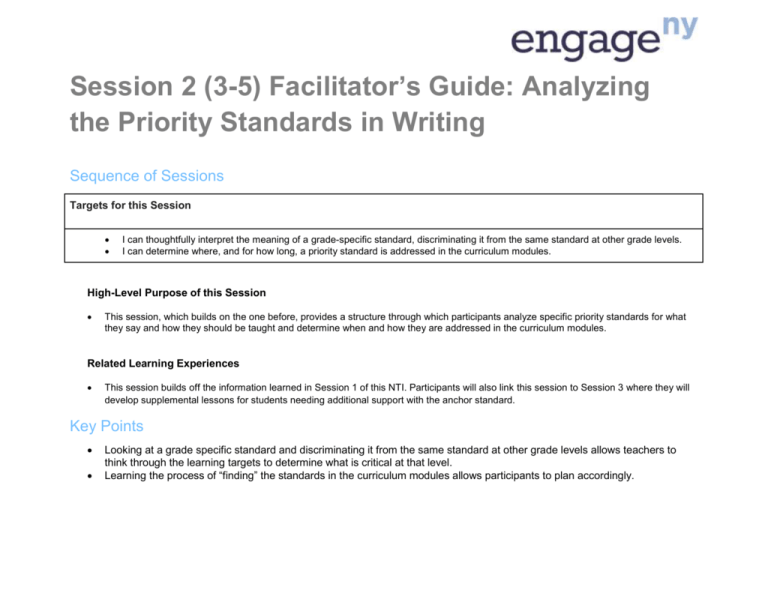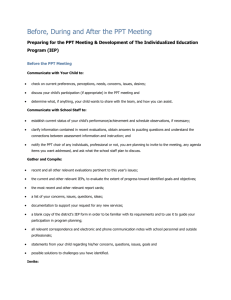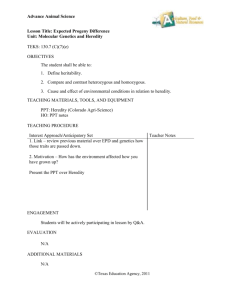Analyzing Priority Standards in Writing and Language, Grades 3-5
advertisement

Session 2 (3-5) Facilitator’s Guide: Analyzing the Priority Standards in Writing Sequence of Sessions Targets for this Session I can thoughtfully interpret the meaning of a grade-specific standard, discriminating it from the same standard at other grade levels. I can determine where, and for how long, a priority standard is addressed in the curriculum modules. High-Level Purpose of this Session This session, which builds on the one before, provides a structure through which participants analyze specific priority standards for what they say and how they should be taught and determine when and how they are addressed in the curriculum modules. Related Learning Experiences This session builds off the information learned in Session 1 of this NTI. Participants will also link this session to Session 3 where they will develop supplemental lessons for students needing additional support with the anchor standard. Key Points Looking at a grade specific standard and discriminating it from the same standard at other grade levels allows teachers to think through the learning targets to determine what is critical at that level. Learning the process of “finding” the standards in the curriculum modules allows participants to plan accordingly. Session Outcomes What do we want participants to be able to do as a result of this session? 1. To be able to interpret the meaning of a grade-specific standard, discriminating it from the same standard at other grade levels. 2. To determine where, and for how long, a priority standard is addressed in the curriculum modules. How will we know that they are able to do this? Identification of key words and phrases within grade levels across the W.2 and L.3 standards. Group Discussion Completion of note catchers Synthesis questions Session Overview Time Overview Creating a Culture of Achievement 40 min Participants will be Language_NTI_NTI1224.pdf introduced to learning targets and participate in Chart paper (1 piece per 5 participants) an initiative Additionally, Markers they will identify key words and phrases in the W.2 2_W2Progressions_NTI1214.pdf and L.3 standards across 2_L3Progressions_NTI1214.pdf grade levels in order to deeply understand the 2_W2ProgressionNC_NTI1214.pdf progression of the standard over time. Read through entire facilitator’s guide and review PPT slides. Participants will closely Gr5_2B_U3_Overview_NTI1224 study the W.2 and L.3 standards by analyzing a AnalyzingDocsNC_NTI1224 lesson plan and grade level Read lesson plan, Grade 6, Module 3B, Unit 3, Lesson 10. Using Module Documents to Analyze a 25 min Prepared Resources Facilitator’s Preparation Section Become familiar with standard W.2 across grades 3-12. Become familiar with Grade 6 Curriculum Map; specifically where W.2 is assessed. Standard Application and Synthesis curriculum map. 20 min Participants will apply what Participant’s Notebook they know about the progression of the standards and structure of module documents to brainstorm possible ideas for supplemental lessons. They will end this session with a synthesis of their learning. Session Roadmap Section 1: Creating a Culture of Achievement Time: 11:15-11:50 [40 minutes] Participants will be introduced to learning targets. 2_Language_NTI1224.pdf Additionally, they will identify key words and phrases in the Chart paper (1 piece per 5 participants) W.2 standard across grade levels in order to deeply understanding the progression of the standard over time. Markers 2_W2Progressions_NTI1214.pdf 2_L3Progressions_NTI1214.pdf 2_W2ProgressionNC_NTI1214.pdf Time 1 min Slide #/Pic of Slide PPT slide #2 Script/Activity directions Introduce the learning targets for this session: 1. I can thoughtfully interpret the meaning of a gradespecific standard, discriminating it from the same standard at other grade levels. 2. I can determine where, and for how long, a priority standard is addressed in the curriculum modules. 3 min PPT slide #3 14 min PPT slides #4-5 Ask participants to work in split table groups. Invite participants to locate the Language Overview document from Appendix A in their Participant’s Notebook. Ask participants to read the document silently. Allot 3 minutes. Ask participants to continue to work in split table groups for this next activity. Distribute 1 piece of chart paper to each group. Tell participants that they will create a Frayer model for the phrase “grammatical knowledge.” The components of the model should include: Center= word to be defined 4 Quadrants= definition in own words characteristics examples non-examples (see PPT slide) When groups are finished, ask one member from each split table group to quickly share their Frayer model. Possible responses on the chart may include: Grouping Whole group Solo Split table groups o Definition- grammar and usage development in spoken and written language. o Characteristics- learners lose mastery of grammar as they learn new structures; need to return often to same grammar topic; recursive; ongoing. o Examples- present, past and future verbs at elementary level progressive and perfect verb tenses in intermediate level. o Non-examples-teaching learners to vary sentence structure ONLY. 2 min PPT slide #6 20 min PPT slides #7-9 Pull the whole group back together and ask, “What are the implications for a common core-aligned curriculum in regards to writing instruction? In regards to language instruction? Ask participants to discuss as a shoulder partner and then ask for a few volunteers to share whole group. Now, have participants locate the L.3 Progressions in their notebooks. Show the PPT slide with the following quote: All you need is the plan, the road map, and the courage to press on to your destination. -Earl Nightengale Ask participants to turn to a partner and discuss the relationship between the quote and standards progressions. Invite participants to read the L.3 standards from grades 2-12; the standards that we examined in Session 1 of this NTI in the data protocol. As they read, they should highlight key vocabulary and phrases that differentiate a grade level standard from those adjacent to it. Pairs Solo Ask participants to locate the Progressions Notecatcher in their Participant’s Notebook. Ask them to record key vocabulary on the note catcher for each grade level. They should focus on subtleties that delineate the L.3. Standard at each particular grade level. Tell them that we are focusing on the component standards that students had difficulty with according to the data examined in Session 1. When they are finished, they should complete the same process for standard W.2. Tell participants that grades K-2 are not provided, as they do not have component standards to compare. Remind participants that from their earlier reading of Appendix A, we know that language standards are also embedded in the reading, writing, speaking and listening standards. Section 2: Using Module Documents to Analyze a Time: 11:50-12:10 Standard [20 minutes] Participants will closely study the W.2 and L.3 standards by analyzing a unit overview lesson plan and grade level curriculum map. Gr5_2B_U3_Overview_NTI1224 AnalyzingModDocsNC_1224 Time 10 min Slide #/Pic of Slide PPT slides #10-12 Script/Activity directions Tell participants that we will dive into the second learning target: 2.) I can determine where, and for how long, a priority standard is addressed in the curriculum modules. Ask folks to locate the Unit Overview in their Participant’s Notebook for Grade 5, Module 2B, Unit 3 on p. X. Tell them the data that they analyzed in Session 1 was a result of the End-of-the-Unit Assessment from this unit. Invite participants to analyze the Unit Overview to trace the evolution of Standard W.2. Say, “Unit Overviews help teachers begin long-term planning and determine how each unit, and lessons within units, emphasize key ideas, build towards assessments, and flow together over several weeks.” After participants are given 3 minutes to read the Unit Overview, direct them to the Analyzing Module Documents Notecatcher in their Participant’s Notebook. Have them complete the first two questions: 1. “How do I understand what the “story” and “big ideas” of the unit are? 2. How do the Unit Overview help teachers support student success? Grouping Whole group; solo 15 min PPT slides #13-14 No slide Next, have participants locate Lesson X and the lesson’s Supplemental Materials in their Participant’s Notebooks. Tell participants that this is the actual module lesson where the assessment results came from for the analysis is Session 1. Ask participants to read through all of the materials, paying particular attention to how the W.2 and L.3 standards were addressed in the lesson and assessment. After 5 minutes, ask participants to answer questions 3 and 4 on the Analyzing Module Documents Notecatcher in their notebooks. 3. What supports have students had that led to this writing task? What additional scaffolds may they need? 4. How are the long-term learning targets, supporting learning targets and assessment related? If time permits, ask a few volunteers to share their thinking with the whole group. Section 3: Application and Synthesis Time: 12:10-12:30 [20 minutes] Participants will apply what they know about the progression of the standards and structure of module documents to brainstorm possible ideas for supplemental lessons. They will end this session with a synthesis of their learning Brainstorming3_5_NC_NTI1224 Whole group Time 15 min 5 min Slide #/Pic of Slide PPT slide #15 PPT slide #16 Script/Activity directions Tell participants that they will now have an opportunity to brainstorm possible ideas for supplemental lessons to re-teach components of standards W.2 or L.3. If possible, group participants by interest in the standard that they would like to delve into. Have them locate the Brainstorming Notecatcher in their notebooks. Draw attention to the four categories on the notecatcher: o Re-teaching transitions o Re-teaching formal style of writing o Re-teaching sentence patterns, language and voice o Re-teaching maintaining style and tone Tell participants that they will have an opportunity to explore supplemental lessons in the next session of this NTI. Show the PPT slide of “Simile Pictures.” Ask participants to chose one picture from the slide and complete this sentence on their Session 2 Reflection page: o Standard progressions are like/ the same as (picture) because… If time, ask a few volunteers to share with the whole group or ‘Go-round’ the table. Grouping Small groups Solo Turnkey Materials Provided Facilitator’s Guide for Session 2 PowerPoint presentation for Session 2 Language_NTI_NTI1224.pdf 2_W2Progressions_NTI1214.pdf 2_L3Progressions_NTI1214.pdf 2_W2ProgressionNC_NTI1214.pdf 2_Gr5_2B_U3_Overview_NTI1224 2_AnalyzingDocsNC_NTI1224 2_BrainstormingNC_NTI1224








